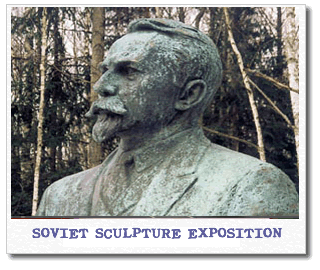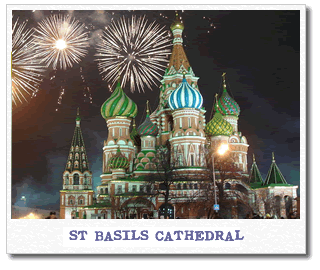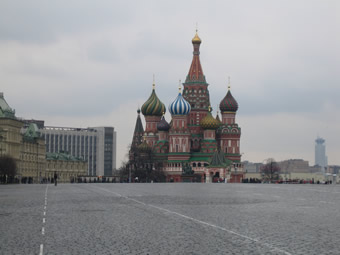Saint Basil’s or the Cathedral of Intercession of Theotokos on the Moat is probably the most known piece of architecture in Moscow. This magnificently coloured cathedral with its onion like domes is one of the world’s great religious buildings. The church celebrates Russian Orthodox and its beginnings date back to 1555 although the vivid colours and architecture were not a feature until the 1680’s and happened in stages over nearly 200 years. The building is meant to be inspired by a bonfire and its architecture is so unique there were no known similarities to it anywhere. It is rumoured that the architect Postnik Yakovlev was blinded by Ivan the Terrible so he would not design anything as magnificent ever again. The building today is part of the UNESCO World Heritage Site which includes the two other major Moscow landmarks Red Square and the Kremlin. The cathedral has been pretty lucky to survive until today. Napoleon was so taken with the St Basil’s that he wanted to dismantle it and move it to Paris but legend tells he didn’t have the technology or manpower to do it. Unhappy with Russia having it and not Paris he then decided no one should have it and ordered it to be blown up. The story goes a sudden shower extinguished the gun powder fuses and the cathedral was saved. St Basil’s was nearly lost in the 1930’s too. Stalin’s Red Square development team planned to knock the structure down to make way for a new grand square luckily the plan didn’t come to fruition. Read the rest of this entry »
Posts Tagged ‘Russia’
The Stalin Museum
We like off beat museums at tripandom and there are plenty of them around the world, but very few are dedicated to dictators. One such museum is the Stalin Museum in the city of Gori, Georgia. The museum shows the life of the Russian dictator Joseph Stalin who was born in the city and went on to lead the USSR from 1922 to 1953. The museum features his personal train carriage, his childhood home as well as many artifacts from his life as well as plenty of statues and artworks of him. Hit up the next page for a short news video about the museum as well as the link to their website where you can see a few galleries of the exhibits. Read the rest of this entry »
Soviet statues and a zoo you can eat

After the fall of the Berlin Wall and the fall of the Soviet control of much of Eastern Europe many of the huge monuments to the rule were removed and in many cases destroyed. But many in Lithuania were later retrieved and restored and are now on display at Grtas park, near Druskininkai in Southern Lithuania which opened in 2001. The park has become a family amusement park, and has a very odd list of attractions, there are over 80 of huge statues of just about every leader to rule the East, including Lenin and Stalin. There’s a few wooden huts with over a million pieces of memorabilia from this period and even a zoo, well a pretty crappy one in more ways than one. Don’t expect any exotic animals unless you are counting the chickens, pigs and the odd ostrich or pheasant- if you like the look of them, head down to the restaurant, they have a few of their zoo exhibits on the menu.. tasty. There’s plenty of market stalls where you can buy your very own Soviet era treasure or even some dodgy beer brewed on the premises. It may not be Disneyland but you will certainly be amazed, although in different ways. if you know what we mean.
Beautiful Saint Basil’s

The beautiful Saint Basil’s Cathedral is located in the south east end of Moscow’s Red Square which is also home to the Kremlin. Under the onion domes lay 9 chapels and are beautifully painted in medieval style in bright swirling colours. Built between 1555 and 1561 and commissioned by Ivan IV better know as Ivan the Terrible to commemorate the capture of Khante of Kazan the cathedral is one of the most known and photographed buildings in Russia. St Basil is very lucky to be still standing with many wars and troubles harming much of the splendor of the Russian Capital, legend had it that Napoleon was so impressed with the structure he wanted to dismantle it and move it back to Paris, and then in the 1930’s some of Stalin’s team thought it would be good to knock it down to make more space for their military parades. Stalin came close a few years later but a culture buff called Baranovsky kicked up a bit of a stink by telling Starlin he would cut his own throat on the steps instead of tear it down. Stalin decided to keep in and chucked poor old Baranovsky in goal for five years. Read the rest of this entry »
The Trans Siberian Railway
The Trans Siberian Railway is one of the world’s great railroad journeys linking Moscow to Beijing via 9,288 kilometres of track that spans eight time zones. The project to build the rail was one of the most expensive in Russian history at the time the first stage was opened in 1916. Technically the Trans Siberian Railway ends at Vladivostok but branch lines continue to North Korea and via the Trans Manchurian line or Trans Mongolian line to Beijing. The video above has a few good shots of the wonderful Russian landscape, it’s no surprise watching this one that this rail journey is so popular. Read the rest of this entry »
The Leningrad Zoo

Located in Alexander Park in St Petersburg is Russia’s oldest zoo. It was founded in 1865 by Sophia and Julius Gerhardt and is today home to over 400 species of animals. The Zoo has had a bit of a sad past, in the early 1900’s the zoo was very run down and closed to visitors. But in 1918 the zoo was restored and hunting expeditions were sent out to capture animals from around the world. But the Second World War brought more problems the poor old hippos had to eat sawdust porridge to survive the city’s siege by the evil Nazis. And although the people of Leningrad were starving the treasured elephants were kept fed and happy until they were sadly killed by bombs in an air raid in 1944. The city’s people were devastated, and the zoo closed for a while before re opening with a new elephant and some other exotic animals. Today the zoo is back to its former glory and a favorite for young and old. Read the rest of this entry »
Visit a modern day ghost town
When the Chernobyl reactor disaster occurred in 1986 a 30 klm area was set up as the Zone of Alienation and everyone that lived in that area was evacuated leaving everything behind, this included the 50000 residents of the town of Pripyat around 5 klm from the reactor and the 14000 residents of the town of Chernobyl around 14 Klm from the Reactor. Today these towns are modern day ghost towns that are slowly falling into ruin and they give us a good glimpse of what 1980s Soviet Russia was like.
Day trips from Kiev in the Ukraine (about 130 klm’s away) can be organized to visit the area, it’s claimed to be fairly safe for short visits and the guide is armed with a Geiger counter so you know where not to stand. If the idea of copping a bit of radiation turns you off visiting the area check out these videos instead, they are mostly of Pripyat, the town closest to the reactor. The town of Chernobyl has got a few plant workers and scientist living in it and what is left is looked after, unlike Pripyat.






